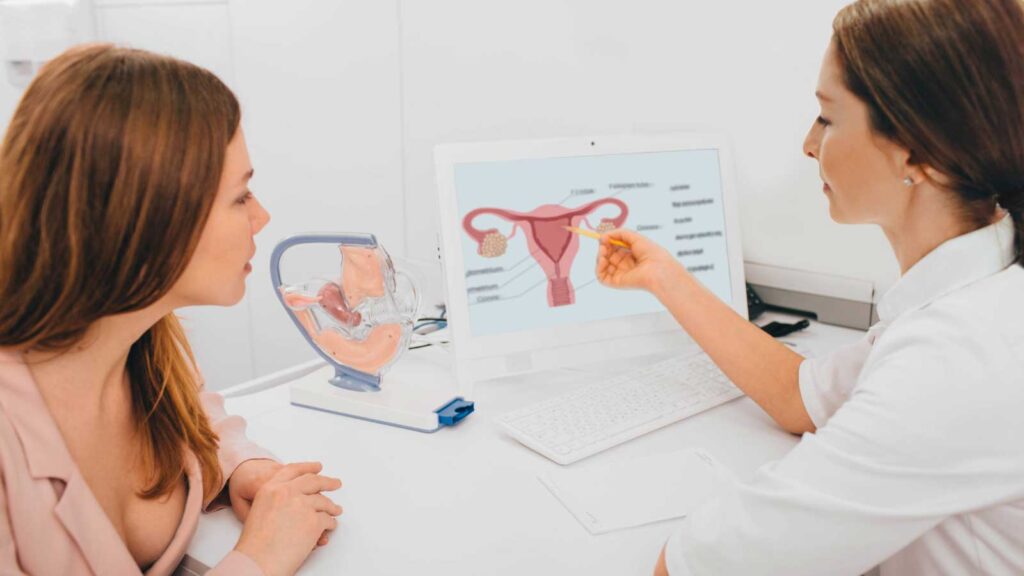What is a Hysterectomy?
Hysterectomy is a surgical procedure that involves removing a woman’s uterus and may or may not affect the removal of other reproductive organs like the cervix, fallopian tubes, and ovaries. It is typically done to manage certain women’s reproductive health concerns to offer permanent relief and effective management.
Not all hysterectomies result in the total removal of female reproductive organs. In other cases, hysterectomy is reserved as a last resort for giving permanent relief from endometriosis, chronic pelvic pain, and others.
Why and When is a Hysterectomy Performed?
Choosing a hysterectomy is a significant decision, often considered after other treatments haven’t provided the relief you need. It’s not taken lightly but can be crucial to reclaiming your health and comfort.
Your OBGYN may recommend a hysterectomy in the following cases:
Persistent heavy bleeding
A hysterectomy is often recommended for persistent heavy bleeding or menorrhagia, which significantly disrupts daily life. If left untreated, you could develop anemia or experience fatigue, which ultimately impacts your quality of life.
A hysterectomy is considered in this case when less invasive treatment options like medication, hormonal replacement therapy, or endometrial ablation don’t help. However, before ordering this procedure, your doctor will carefully discuss its impacts on fertility.
Mainly, if your quality of life is compromised by heavy bleeding and you don’t plan on having children in the future, a hysterectomy may provide significant relief.
Fibroids
Fibroids are non-cancerous growths in the uterus that can cause discomfort, pain, and other health issues. This surgical option is considered when it’s starting to diminish your quality of life, cause heavy menstrual bleeding, frequent urination, pelvic pressure or pain, and complications during pregnancy and labor.
Fibroids vary in size. While medications help manage smaller ones, more extensive or multiple fibroids might require a hysterectomy.
Prolapsed Uterus
A prolapsed uterus, characterized by weakened pelvic floor muscles causing the uterus to fall into the vaginal canal, leads to significant discomfort and issues with urination, bowel movements, or sexual activity. This condition often prompts consideration of a hysterectomy as a treatment option, primarily to relieve the discomfort associated with the prolapse.
Before recommending a hysterectomy, several critical factors are considered, including the patient’s age, overall health, the severity of symptoms, and future pregnancy plans. This surgical option is typically viewed as a last resort to restore quality of life when other treatments have been exhausted or deemed ineffective.
Severe Endometriosis
Severe endometriosis is characterized by the growth of uterine lining tissue outside the uterus. This growth causes severe pain, fertility issues, and other systemic health problems.
Early-stage Uterine Cancer
A hysterectomy is done here as a means to remove the cancerous cells confined to the uterus effectively. This primarily aims to prevent the cancer from spreading. This approach focuses on eradicating the source of cancer while preserving as much of the patient’s reproductive system as possible. It’s a proactive step that offers a high chance of a cure in the early stages of the disease, making it a pivotal treatment option for those diagnosed.
Potential Risks and Complications
Like any major surgery, a hysterectomy has potential risks and complications. It’s essential to be aware of these possibilities to make an informed decision and prepare for any eventualities, whether these are short-term or long-term risks.
Short-term Risks
Short-term risks of hysterectomy are typical of any major surgical procedure. These include:
- Infection: One of the primary concerns following any surgical procedure is the risk of infection. Infections can occur at the incision site, within the pelvic area, or in other parts of the body. Symptoms of infection include redness, swelling, increased pain, fever, and discharge from the incision site.
- Bleeding: Excessive bleeding during or after the surgery is another potential complication. While some bleeding is expected, severe bleeding may require additional medical intervention. This could involve blood transfusions or, in rare cases, a second surgery to control the bleeding.
Long-term Risks
In addition to short-term risks, several long-term risks are associated with hysterectomy. These can include:
- Adhesions: Scar tissue that can form between abdominal tissues and organs, potentially causing pain or bowel obstructions.
- Pelvic floor dysfunction: Weakening of the pelvic floor muscles, which can lead to urinary incontinence or prolapse of the vaginal cuff.
- Hormonal changes: Removing the ovaries causes hormonal changes as they are the primary organ for regulating these. Sudden drops in estrogen and progesterone levels induce immediate menopause, regardless of the patient’s age. Ergo, you may begin experiencing menopause symptoms like vaginal dryness and hot flashes.
- Impact on sexual health: A hysterectomy can affect sexual health in various ways. Some women may experience a decrease in sexual desire or discomfort during intercourse. Conversely, some women report improvements in sexual health post-hysterectomy, mainly if it eliminates conditions that previously disrupted their sex life.
Understanding these potential risks and complications can help patients make informed decisions about undergoing a hysterectomy and preparing for recovery. Discussing all concerns with a healthcare provider is crucial to ensure a comprehensive understanding of the procedure and its implications.
The Hysterectomy Procedure
There are different methods for conducting a hysterectomy. These methods are designed to cater to varying degrees of health needs and patient preferences. Below, we describe how each is done.
Abdominal Hysterectomy
An abdominal hysterectomy involves making an incision in the lower abdomen to remove the uterus. This method is often chosen when a larger incision is needed to access the uterus, such as in cases of large fibroids or extensive endometriosis. The incision can be horizontal or vertical, depending on the specific situation. Recovery typically involves a hospital stay of several days and a recovery period of about six to eight weeks.
Vaginal Hysterectomy
In a vaginal hysterectomy, the uterus is removed through an incision made in the vagina. This approach is less invasive than an abdominal hysterectomy and usually results in a shorter hospital stay and quicker recovery. It is often preferred for conditions where the uterus is not enlarged, and there is no need for extensive pelvic surgery.
Laparoscopic Hysterectomy
A laparoscopic hysterectomy is a minimally invasive procedure where small incisions are made in the abdomen, and a laparoscope (a thin, lighted tube) is used to guide the surgery. The uterus is removed in small pieces through these incisions. This method offers the benefits of less postoperative pain, a shorter hospital stay, and a quicker return to normal activities compared to an abdominal hysterectomy.
Robot-assisted Surgery
Robotic-assisted hysterectomy is similar to laparoscopic surgery but involves a robotic system. The surgeon controls the robotic instruments, which provide greater precision and flexibility. This approach can be beneficial for complex cases requiring meticulous dissection and suturing. The advantages include reduced blood loss, less pain, and a faster recovery.
What to Expect During Surgery
Understanding what happens during surgery can help alleviate some anxiety. Here are key details:
- Anesthesia: General anesthesia is typically used, meaning the patient will be asleep and pain-free during the procedure. In some cases, spinal or epidural anesthesia may be used.
- Duration of surgery: The length of the surgery can vary but usually lasts between one to three hours, depending on the complexity of the case.
- Immediate postoperative care: After the surgery, the patient will be moved to a recovery room to be monitored as the anesthesia wears off. Pain management, hydration, and vital signs monitoring are priorities during this period.
Recovery After Hysterectomy
Recovering from a hysterectomy requires careful management and attention to various aspects of postoperative care. Here’s a comprehensive guide to help you through the recovery process:
- Pain management: Your doctor will prescribe pain medications to help manage discomfort. It’s essential to take these medications as directed and communicate with your healthcare provider if you feel the pain is not well controlled.
Over-the-counter pain relievers, such as ibuprofen or acetaminophen, may also be recommended for mild pain. Remember to avoid any medications not approved by your doctor, as they could interfere with your recovery.
- Activity restrictions: Postoperative activity restrictions are essential to ensure proper healing. Avoid heavy lifting and limit strenuous activities, as these may cause your stitches to open, especially if you underwent open surgery.
Once the operative wound heals more, you can resume activities gradually—introducing more intensity or frequency as is tolerated.
- Incision care: Proper care of your incision site is vital to prevent infection and promote healing:
- Keep the area clean and dry by washing it with mild soap and water and pat dry. Avoid soaking in baths until cleared by your doctor.
- Monitor for signs of infection like redness, swelling, increased pain, or discharge from the incision site.
- Adhere to any specific wound care instructions provided by your surgeon.
- Do pelvic floor exercises: Kegel exercises can help strengthen pelvic floor muscles. Your doctor can advise when it is safe to start these exercises.
- Avoid sitting for long periods: Get up and move around every hour to promote blood flow and reduce the risk of blood clots.
- Seek support: Talk to family and friends about your feelings. Joining a support group can connect you with others who understand what you’re going through.
Final Thoughts
A hysterectomy is a significant surgical procedure that offers a permanent solution to various reproductive health issues. However, given its drastic and irreversible nature, it is generally considered a last resort after exploring less invasive treatment options.
Exploring alternatives to hysterectomy can provide effective relief for many conditions without surgery. Treatments such as medications, minimally invasive procedures, and lifestyle changes can often manage symptoms and improve quality of life. Discussing all available options with your OBGYN can help you find the most suitable and least invasive treatment for your condition.

